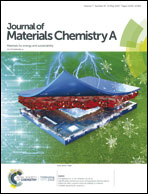A unique sandwich structure of a CoMnP/Ni2P/NiFe electrocatalyst for highly efficient overall water splitting†
Abstract
Rational design of active and stable bifunctional electrocatalysts for both hydrogen evolution and oxygen evolution reactions is critical for the realization of renewable energy technologies. Although direct growth of active two-dimensional (2D) nanosheets on the current collector is an effective method to improve the exposure of active sites, the inefficient electron transfer and weak electron interaction between 2D nanosheets and current collectors greatly limit their overall electrochemical performance. Herein, a unique sandwich structure of CoMnP/Ni2P/NiFe is successfully designed via introducing a Ni2P interlayer between CoMnP nanosheets and nickel–iron (NiFe) foam to achieve an excellent bifunctional electrocatalyst in alkaline media. The metallic Ni2P interlayer does not only improve the electron transfer from the current collector of NiFe foam to the catalyst of CoMnP, but also enhances the intrinsic activity of each active site via strong electron interaction. Electrochemical studies show that the resulting electrocatalyst exhibits superior electrocatalytic activity, such as giving a low cell voltage of only 1.48 V at 10 mA cm−2 stably for a long time when applied as both the cathode and anode in alkaline solutions. These results evidently indicate the superior electrochemical characteristics of this sandwich structure, which may provide a new insight into the design of electrocatalysts for different utilizations.



 Please wait while we load your content...
Please wait while we load your content...